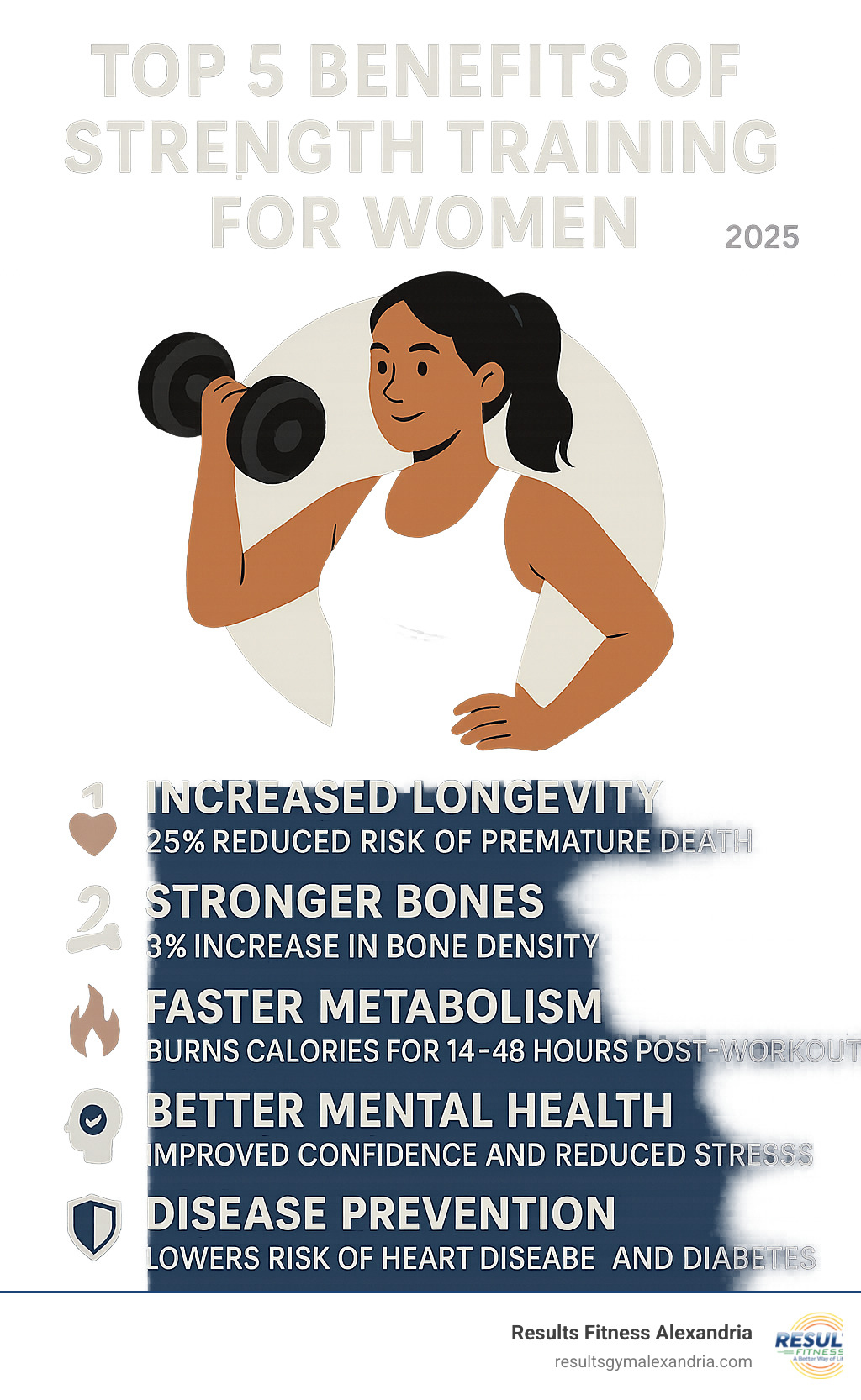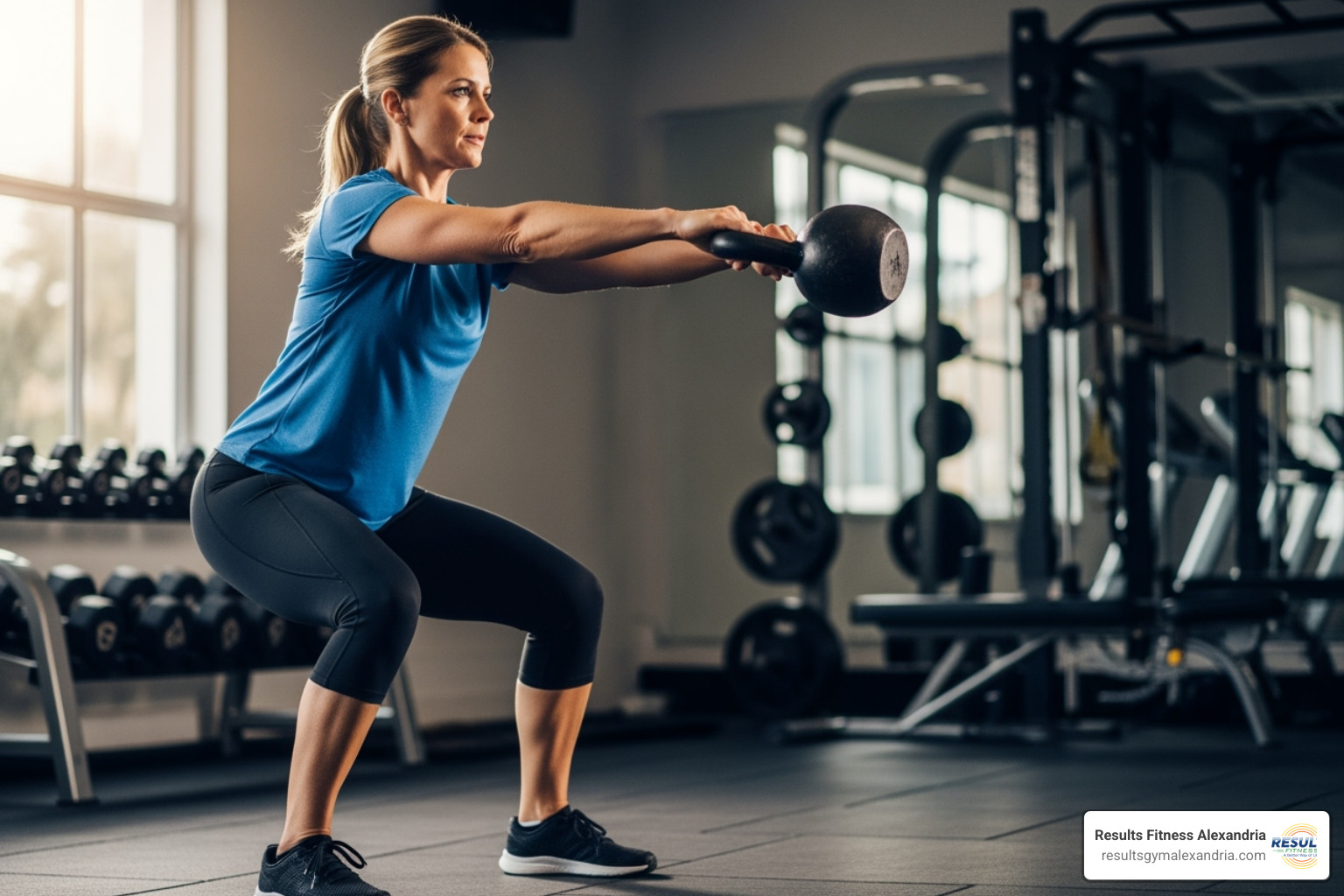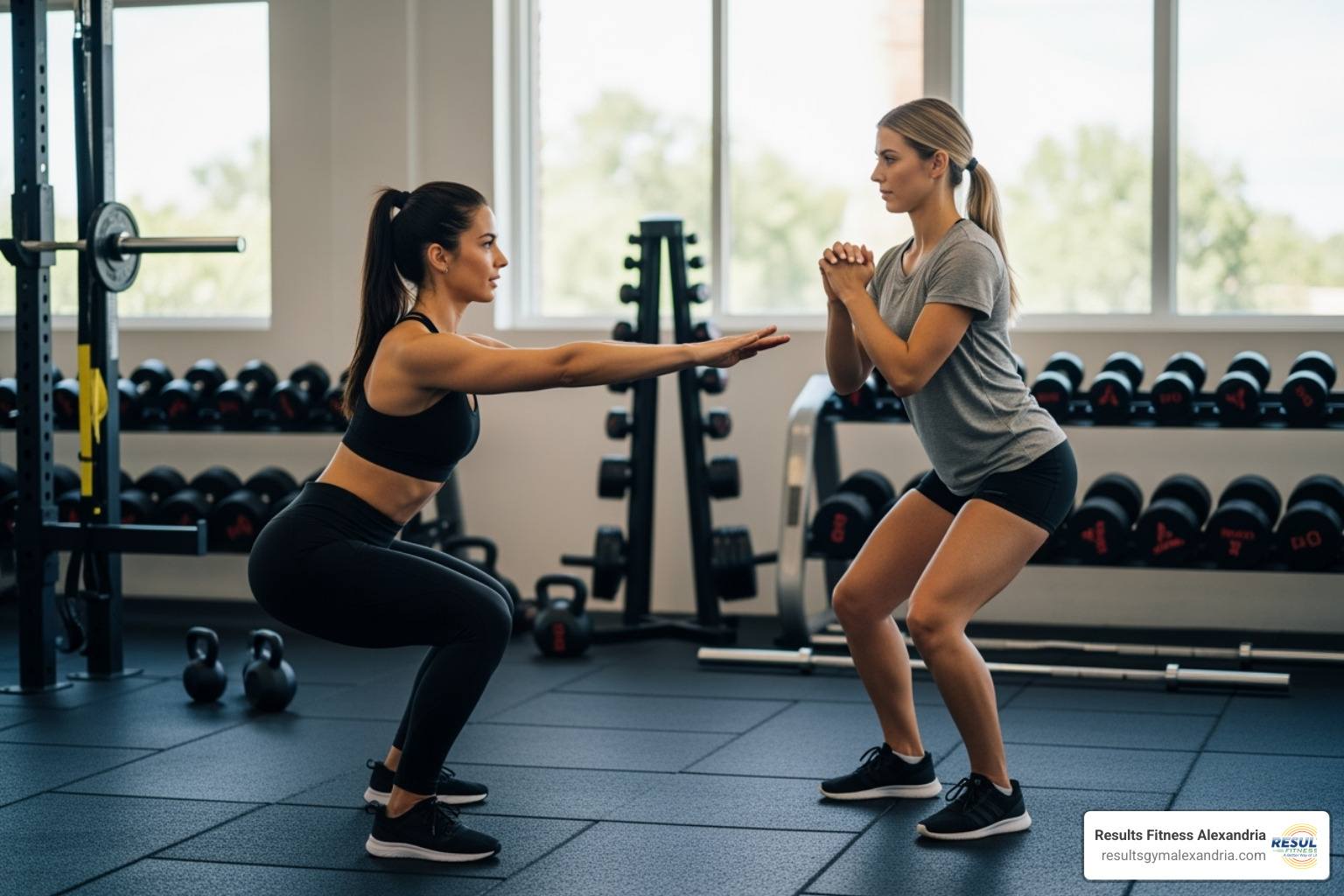Strength Training for Women: 5 Transformative Benefits
Why Strength Training for Women is Your Key to a Longer, Healthier Life
Strength training for women is about more than building muscle—it’s your key to a longer, healthier life. Research shows that women who lift weights are significantly less likely to die prematurely. Yet, many still avoid the weight room due to outdated myths.
Top 5 Benefits of Strength Training for Women:
- Increased Longevity: Reduces premature death risk.
- Stronger Bones: Prevents osteoporosis and increases bone density.
- Faster Metabolism: Boosts metabolism for up to 48 hours post-workout.
- Better Mental Health: Improves confidence and reduces stress.
- Disease Prevention: Lowers risk of heart disease, diabetes, and age-related muscle loss.
After age 30, you lose 3-8% of muscle mass per decade. Strength training is the best way to combat this decline and maintain independence. This guide will show you how to start, no matter your experience level.
I’m Jennifer Rapchak, Fitness Director at Results Fitness Alexandria. With over 14 years of experience as a personal trainer specializing in strength training for women, I’ve helped hundreds of women transform their lives.

Learn more about strength training for women:
The Life-Changing Benefits: Why Every Woman Should Lift
Strength training for women fundamentally changes how you move through life—with more energy, confidence, and strength. Imagine carrying all your groceries in one trip or playing with your kids without getting winded. This is the power of embracing the weight room.

The research is clear: women who do resistance training live longer, healthier lives. Scientific studies show a significantly lower risk of premature death. But it’s not just about adding years to your life; it’s about adding life to your years. Your metabolism also gets a major upgrade. Thanks to the “afterburn effect,” your body continues to burn calories for up to 48 hours after a workout. This means you get stronger and leaner even while you rest.
Beyond the physical, strength training is a superpower for your mental health. The confidence from lifting heavy and the stress relief from a great session are unparalleled. It also boosts good cholesterol, lowering your risk of heart disease, stroke, and other chronic illnesses like diabetes. Learn more about functional fitness benefits here.
Stronger Bones for a Stronger Future
Let’s talk about your bones. After 30, we lose 3-8% of our muscle mass each decade, which impacts not just strength but long-term independence. Strength training is like sending your bones to construction school; every lift signals your body to build stronger, denser bone. This is crucial, especially after menopause when bone loss accelerates.
Research shows that postmenopausal women can increase bone density by up to 3% by training just twice a week. This means fewer fractures, better balance, and the ability to stay active for life. It’s never too late to start building your bone bank account. Find more about strength training for all ages.
Strength training adapts to support you through every life stage. It builds confidence in your teens, supports a healthy pregnancy (with a doctor’s approval, as confirmed by ACOG guidelines), helps manage menopause symptoms, and acts as your independence insurance in your later years.
Every pound of muscle you build increases your resting metabolism, turning your body into a more efficient, fat-burning machine. Studies prove that women who combine strength training with their fitness routine lose significantly more fat than those who only do cardio. It’s about real body composition changes for a healthier you.
Getting Started: Your First Steps into the Weight Room
Taking the first step into the weight room can feel intimidating, but every strong woman you see was once a beginner. Let’s clarify some terms. Strength training is the umbrella term for using resistance (weights, bands, bodyweight) to build muscle. Weight training specifically uses weights like dumbbells or barbells. We’re focused on using resistance to build strength, health, and confidence.
Your initial goal might be as simple as carrying groceries without strain. Start there. Perfect form is always more important than heavy weight. Most people in the gym are focused on their own workout, so don’t feel intimidated.

More info on creating a beginner workout routine
Key Principles and Equipment
The foundation of success is consistency. The CDC recommends strength training at least twice a week, which is a perfect starting point. Two to three 30-minute sessions per week, with a rest day in between, allows your muscles to recover and grow stronger. Rest days are growth days. Your muscles get stronger during recovery, not the workout itself. Listen to your body; normal soreness is fine, but sharp pain is a signal to slow down.
You don’t need much to start. Bodyweight training is perfect for beginners. Exercises like squats, push-ups (on a wall or incline), and planks build a strong foundation. As you progress, you can add equipment.
| Equipment Type | Pros | Cons | Ideal For |
|---|---|---|---|
| Bodyweight | Free, available anywhere, builds foundational strength | Limited resistance options, harder to isolate muscles | Complete beginners, travel workouts |
| Dumbbells | Versatile, great for home use, allows single-arm work | Can be expensive for full range, requires storage space | Home workouts, targeting specific muscles |
| Barbells | Handles heaviest weights, efficient for compound lifts | Requires proper technique, often needs spotter | Building maximum strength, experienced lifters |
| Machines | Safe for beginners, easy to learn, isolates muscles well | Less functional movement, limited to gym use | Learning proper form, specific muscle targeting |
Master bodyweight movements first, then gradually add resistance as you build confidence. The best equipment is what you’ll use consistently. More info on post-workout recovery
The Ultimate Strength Training for Women Blueprint
A great strength program focuses on compound exercises—movements that work multiple muscle groups at once. This gives you the most value for your time and builds functional strength for everyday life.
For beginners, a full-body routine 2-3 times per week is ideal. This works all major muscle groups while allowing for adequate recovery. A simple structure is to select 5-7 compound exercises, performing 3 sets of 8-12 repetitions for each. Choose a weight that makes the last two reps challenging but doable with perfect form. Rest for 60-90 seconds between sets.

More info on the science of building muscle
[LIST] of the 7 Best Foundational Exercises
Master these seven movements to build lasting strength:
- Squats: The ultimate lower body exercise for daily movements.
- Deadlifts: A full-body powerhouse that teaches proper lifting mechanics.
- Push-ups: Perfect for upper body and core strength (use wall/incline variations to start).
- Overhead Press: Builds shoulder stability for overhead reaching.
- Bent-Over Rows: Strengthens your back to improve posture.
- Glute Bridges: Activates and strengthens your glutes.
- Lunges: Improves single-leg strength, balance, and stability.
How to Progress and Balance Your Routine
To keep getting stronger, you need progressive overload—gradually increasing the challenge. Once you can complete all your reps with good form, it’s time to progress. You can do this by:
- Increasing weight (by about 5%)
- Increasing reps or sets
- Decreasing rest time
- Improving your form and tempo
Track your workouts in a simple log to monitor your progress and stay motivated.
While strength training should be your foundation, don’t forget cardio. The American College of Sports Medicine recommends 150 minutes of moderate aerobic exercise per week. If strength is your main goal, lift first, then do cardio. You can also do them on separate days. Find a balance that fits your schedule and goals. More info on integrating strength and cardio
Busting Myths and Avoiding Common Mistakes
After 14 years as a trainer, I’ve seen the same mistakes hold women back. Avoid these common pitfalls to train with confidence:
- Lifting too heavy too soon: Master form with lighter weights first. Good technique prevents injury and ensures results.
- Neglecting rest: Your muscles grow during recovery, not during the workout. Rest is essential for progress.
- Being inconsistent: Consistency beats intensity. Two solid workouts a week for months is better than sporadic, intense sessions.
- Using poor form: Every rep should be controlled. If you’re unsure, ask a trainer or watch reputable videos.
More info on finding gym motivation
The “Bulky” Myth: Why You Won’t Look Like a Bodybuilder
Let’s tackle the number one fear: “I don’t want to get bulky.” This is a myth. You will not accidentally wake up looking like a competitive bodybuilder.
Women produce significantly less testosterone—the primary muscle-building hormone—than men. The “bulky” look requires years of specific, intense training and nutrition protocols that you won’t be following by accident.
Instead, strength training will give you a strong, lean, and toned physique. Your muscles will become more defined, your posture will improve, and your clothes will fit better because muscle takes up less space than fat. You’ll feel powerful and confident. Research on gender differences in muscle mass
Nutritional Support for Your Strength Journey
You can’t out-train a poor diet. Nutrition is just as important as your workouts. Think of food as fuel and building blocks.
- Prioritize Protein: It’s essential for muscle repair. Aim for lean sources like chicken, fish, eggs, Greek yogurt, or beans.
- Fuel Your Workouts: Have a small carb-based snack (like a banana) before you train and a protein-focused meal or shake within a couple of hours after.
- Stay Hydrated: Water is crucial for performance and recovery.
- Don’t Under-eat: Your body needs adequate fuel to build muscle. Focus on whole, nutrient-dense foods, not severe calorie restriction.
Frequently Asked Questions about Strength Training
Here are answers to common questions we get at Results Fitness Alexandria about strength training for women.
How quickly will I see results from strength training?
You’ll feel stronger and more capable within 2-4 weeks as your nervous system adapts. Most women notice visible muscle definition and improved posture around 6-8 weeks of consistent training. Bone density improvements are a long-term benefit, typically seen after 6-12 months. The key is consistency!
Is it better to lift heavy weights with low reps or light weights with high reps?
Both are effective, and the best approach depends on your goals.
- Heavy weight/low reps (3-6): Best for building pure strength and power.
- Light weight/high reps (12-20+): Best for building muscular endurance.
For general fitness and a “toned” look, a balanced approach focusing on the 6-12 rep range is ideal. This stimulates muscle growth effectively. The most important thing is to challenge your muscles to the point of fatigue while maintaining good form.
Can I do strength training every day?
No, this isn’t recommended. Your muscles grow and get stronger during the recovery period between sessions, which typically takes about 48 hours. Training the same muscles every day can lead to overtraining, fatigue, and injury.
For beginners, 2-3 full-body strength sessions per week is the sweet spot. On your “off” days, focus on active recovery like light walks, stretching, or yoga. Listen to your body—if you’re feeling rundown, prioritize rest.
Conclusion: Accept Your Strength, Transform Your Life
This guide has shown that strength training for women is a powerful tool for a life filled with energy, confidence, and vitality. From increased longevity and stronger bones to a boosted metabolism, the benefits are undeniable.
The most powerful change, however, is mental. Finding your physical strength is empowering. The myths that may have held you back—like the fear of getting “bulky”—are just that: myths. Your body is capable of incredible things.
This journey is about consistency and progress, not perfection. Every rep is an investment in your future self. At Results Fitness Alexandria, we’ve seen countless women transform their lives through strength training, and this can be your story, too.
Ready to start? We’d love to support you. Experience what strength training for women can do for you with our free 1-day pass.
Start your strength journey in our women’s gym
Your strongest, most confident self is waiting.
